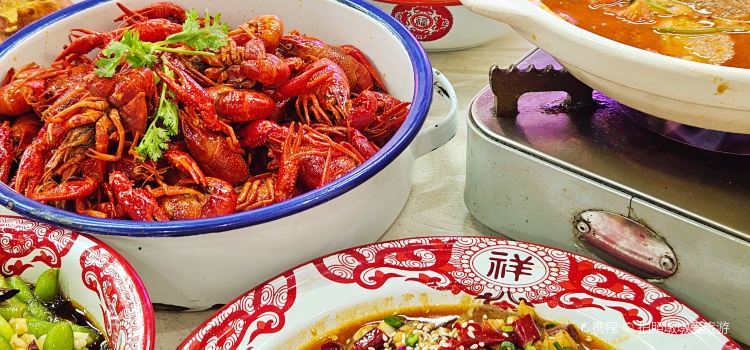虾皇(龙虾城旗舰店)
3.6/549 Reviews
US$22

Currently closed|Open tomorrow at 09:00
0728-3500777
What travelers say:

There is a full shrimp banquet, the taste is greatly improved, 30 people ate 3 full shrimp banquets, the fighting power is super strong. There are also lotus pods, lotus roots, lamb skewers, duck necks, etc. The garlic shrimp is the best, not spicy, not salty, the company chooses to eat shrimp here for meetings.
More
Reviews of 虾皇(龙虾城旗舰店)
Some reviews may have been translated by Google Translate
3.6/5Good
All (49)
Latest
Photo reviews (8)
Positive reviews (3)
Negative reviews (2)
There is a full shrimp banquet, the taste is greatly improved, 30 people ate 3 full shrimp banquets, the fighting power is super strong. There are also lotus pods, lotus roots, lamb skewers, duck necks, etc. The garlic shrimp is the best, not spicy, not salty, the company chooses to eat shrimp here for meetings.
The shrimps are plump and the meat is chewy. The braised prawns are spicy, fresh, mellow and sweet. You can slowly experience the different changes in your taste buds by closing your eyes. Sorry, I am a super foodie. The garlic shrimps are fragrant and delicious. The secret lamb chops are endless. The restaurant environment is super shocking.
It tastes great. I haven’t been home for many years and this time I passed by and enjoyed the authentic taste!
The taste is good, the environment is good, but there are too many people and the service attitude is not very good
Qianjiang, a municipality directly under the jurisdiction of Hubei Province, is known as "Cao Yu's Hometown, Jianghan Oil City, Waterside Gardens, and Lobster Hometown." The following is an introduction to the city: • Geographical Environment: Located in south-central Hubei Province, in the heart of the Jianghan Plain, it borders Xiantao City to the east, Jingmen and Jingzhou Cities to the west, Jianli County to the south, and the Han River to the north. The municipal area covers 2,004 square kilometers and is interwoven with rivers and canals. It has a northern subtropical monsoon humid climate with distinct four seasons, hot summers and cold winters, and abundant heat and rainfall. • Historical Evolution: Qianjiang was once a corner of the Yunmeng Lake. During the Spring and Autumn Period, it belonged to the Chu State. During the Qin Dynasty, it belonged to Jingling County. During the Han Dynasty, it was divided between Jingling and Huarong Counties. In the third year of the Qiande reign of the Song Dynasty (965 AD), it was upgraded from Baifu Xunyuan to a county. Because a river within the area diverts the Han River into the Yangtze River, the name Qianjiang, meaning "Han River flows out to Qian," was derived. In 1988, the county was abolished and established as a city. In 1994, it was designated a directly administered city by Hubei Province. • Cultural Heritage: As one of the birthplaces of Chu culture, the area boasts the ruins of Zhanghuatai, the imperial palace of King Ling of Chu during the Eastern Zhou Dynasty, known as the "First Terrace in the World." It is also the hometown of the renowned dramatist Cao Yu. Qianjiang boasts five national intangible cultural heritage items, including flower drum opera, shadow puppetry, and Qianjiang folk songs, and 29 provincial intangible cultural heritage items. Jianghan Plain shadow puppetry has been inscribed on the United Nations Representative List of the Intangible Cultural Heritage of Humanity. • Economic Development: In 2024, the region's GDP reached 95.197 billion yuan, ranking 71st among the top 100 county economies in China. Qianjiang is the birthplace of the efficient "shrimp-rice farming" model. The "Qianjiang Lobster" brand is valued at 42.229 billion yuan, ranking first among similar brands in China for six consecutive years. Qianjiang is also the world's largest production base for taurine and bleaching powder, Asia's largest oil drill bit production base, and China's largest ophthalmic medication production base. The "Qianjiang Tailor" brand is valued at 23.425 billion yuan, and its textile and garment industry exceeds 30 billion yuan. • Tourism Resources: Qianjiang boasts national 4A and 3A-rated tourist attractions, including Fanwan Lake National Wetland Park, Longwan National Archaeological Site Park, Cao Yu Cultural Tourism Zone, and Tuochuanbu Red Tourism Scenic Area. It is also the site of the Xinglong Water Conservancy Project for the South-to-North Water Diversion Project and the second home of the Metasequoia glyptostroboides, a "living fossil" of the plant kingdom. • Transportation Location: Located in central Hubei Province, Qianjiang serves as a key bridge connecting the Wuhan metropolitan area with Yichang, Xiangyang, and other cities. The Shanghai-Chengdu Railway, Shanghai-Chongqing Expressway, and National Highway 318 run across the park from east to west, while the Zaoshi Expressway, National Highway 234, and National Highway 240 run north to south. The Jianghan Plain freight railway directly connects to the park. The Zekou Port Area of Qianjiang Port has four thousand-ton berths and is directly connected to the Yangtze River through the Han River waterway, providing convenient transportation.